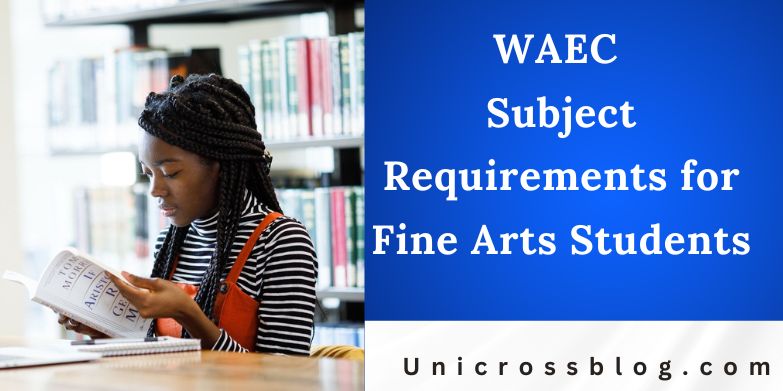The West African Examinations Council (WAEC) plays a crucial role in shaping the academic foundation of students across Nigeria and other West African countries. For students passionate about Fine Arts, selecting the right subjects during the Senior Secondary Certificate Examination (SSCE) is essential. Fine Arts encompasses creative disciplines like painting, sculpture, graphics, textiles, ceramics, and fashion design. It fosters visual expression, cultural appreciation, and innovative thinking, preparing students for careers in galleries, design studios, advertising, education, and more.
WAEC requires candidates to register for a minimum of eight and a maximum of nine subjects, with at least five credits (grades A1 to C6) needed for university admission. As Fine Arts falls under the Arts stream, students must prioritize compulsory core subjects while incorporating art-specific ones to build a strong portfolio. These requirements align with Joint Admissions and Matriculation Board (JAMB) guidelines, ensuring eligibility for undergraduate programs in Fine and Applied Arts at institutions like the University of Nigeria, Nsukka, or Ahmadu Bello University.
The focus here is on O’Level (WAEC) subjects, as they form the gateway to higher education. Choosing wisely not only meets entry criteria but also hones skills like observation, creativity, and technical proficiency. For instance, excelling in Fine Art during WAEC can demonstrate practical talent, which universities often assess through portfolios.

Compulsory Subjects for All Art Students
Every WAEC candidate, regardless of specialization, must include these foundational subjects. They ensure a balanced education and are non-negotiable for Fine Arts aspirants.
- English Language: This is the cornerstone of communication. It tests comprehension, essay writing, and oral skills, all vital for articulating artistic concepts in critiques or proposals. A credit pass is mandatory for all university admissions.
- Mathematics: Often dreaded by creatives, but it sharpens logical thinking and spatial reasoning, useful in design proportions and budgeting art projects. Some universities accept a pass (D7-E8), but aim for at least C6 to broaden options.
- Civic Education: Introduced to promote ethical citizenship, it covers governance, rights, and responsibilities. It encourages reflection on art’s societal role, like using visuals for social commentary.
- One Nigerian Language: Options include Igbo, Yoruba, or Hausa. This preserves cultural heritage and enhances storytelling in indigenous motifs, a key aspect of African Fine Arts. It’s compulsory for Arts students but not for Science or Commercial streams.
These four subjects form the bedrock, leaving room for electives tailored to Fine Arts.
Recommended Elective Subjects for Fine Arts
To specialize, Art students select four to five electives from a pool of Arts and Social Science subjects. For Fine Arts, prioritize those that develop aesthetic sense and technical skills. The ideal combination includes:
- Fine Art (or Visual Arts): The star subject. It involves practical components like drawing, painting, modeling, and printmaking, alongside theory on art history and elements of design. A credit here is indispensable, as most universities require it explicitly for Fine Arts admission. It showcases your portfolio potential early.
- Literature-in-English: This explores narratives, symbolism, and human experiences through prose, poetry, and drama. It inspires thematic depth in artworks, such as illustrating literary motifs or cultural tales.
- Government or History: Government delves into political systems and ideologies, while History traces societal evolution. Both provide context for art as a historical or activist tool, like depicting colonial struggles in paintings.
- Economics or Commerce: Economics introduces resource allocation and market dynamics, relevant for art entrepreneurship (e.g., pricing sculptures). Commerce covers business basics, aiding gallery management or freelance illustration.
- Christian Religious Studies (CRS) or Islamic Religious Studies (IRS): These offer moral and philosophical insights, enriching symbolic art. Choose based on your background; they foster ethical creativity.
A sample nine-subject combination for a Fine Arts-bound student: English Language, Mathematics, Civic Education, Yoruba (or preferred Nigerian language), Fine Art, Literature-in-English, Government, Economics, and CRS/IRS. This mix satisfies WAEC’s diversity rule while aligning with university brochures.
Why These Subjects Matter for Fine Arts
Fine Arts demands more than talent; it requires interdisciplinary knowledge. English and Literature sharpen descriptive skills for artist statements. Mathematics aids in geometric compositions or digital design software. Civic Education and a Nigerian Language ground art in local identity, countering globalization’s homogenizing effects. Fine Art itself builds hands-on expertise, from sketching techniques to color theory.
Neglecting core subjects can derail admission. For example, without Fine Art credit, even stellar JAMB scores won’t secure a spot in competitive programs. Universities like the University of Lagos emphasize Visual Arts proficiency, often requiring practical demos. Moreover, these subjects prepare for real-world challenges: Economics for sustaining a studio, History for contextualizing exhibitions.
Preparation Tips
Start early by practicing daily sketches and analyzing masterworks like those of Ben Enwonwu. Use WAEC past questions to familiarize with exam formats, especially Fine Art’s practical paper (60% of the score). Join art clubs for peer feedback and experiment with mediums like charcoal or acrylics.
Balance theory and practice: Dedicate 40% of study time to electives’ creative aspects. Seek teacher guidance on portfolios, as universities value them alongside grades. Health-wise, maintain focus with routines; creativity thrives on rest. Finally, remember grades reflect effort, not innate genius. Many iconic artists, from Picasso to local talents like Bruce Onobrakpeya, iterated through failures.
In summary, WAEC subjects for Fine Arts students blend compulsion with creativity, paving the way for vibrant careers. With diligent preparation, these requirements transform passion into profession.
READ ALSO: WAEC Subject Requirements for International Relations
FAQs
Is Fine Art compulsory for WAEC if I want to study it at university?
Yes, a credit pass in Fine Art (or Visual Arts) is required by most Nigerian universities for Fine Arts admission. It’s the primary indicator of your artistic aptitude.
Can I substitute Mathematics with another subject for Fine Arts?
No, Mathematics is compulsory for all WAEC candidates. However, some universities accept a pass (D7) in it for Arts courses, but a credit strengthens your application.
What if I fail to get a credit in English Language?
You’ll need to retake it, as it’s mandatory for all admissions. English underpins communication in Fine Arts, from critiques to grant proposals.
How many subjects should a Fine Arts student register for in WAEC?
Register for nine subjects: four compulsory (English, Maths, Civic Education, Nigerian Language) plus five electives, including Fine Art.
Is a Nigerian Language really required for Art students?
Yes, WAEC mandates one for Arts streams to promote cultural preservation. Choose Igbo, Yoruba, Hausa, or another approved option based on your region.
Can Science students switch to Fine Arts with their WAEC results?
Possibly, if they included Fine Art and met the five-credit rule. However, Arts students have an edge with tailored electives like Literature.
What grade do I need in Fine Art for competitive universities?
Aim for A1-B3 to stand out, especially for programs at UNILAG or ABU. Combined with a strong JAMB score (at least 200), it boosts chances.
Are trade subjects relevant for Fine Arts?
Not typically; WAEC’s trade subjects (e.g., Catering) suit vocational paths. Stick to Arts electives unless pursuing applied design like fashion.
How does WAEC Fine Art exam work?
It includes theory (40%) on art principles and history, plus practical (60%) where you create pieces like still-life drawings or sculptures under supervision.







